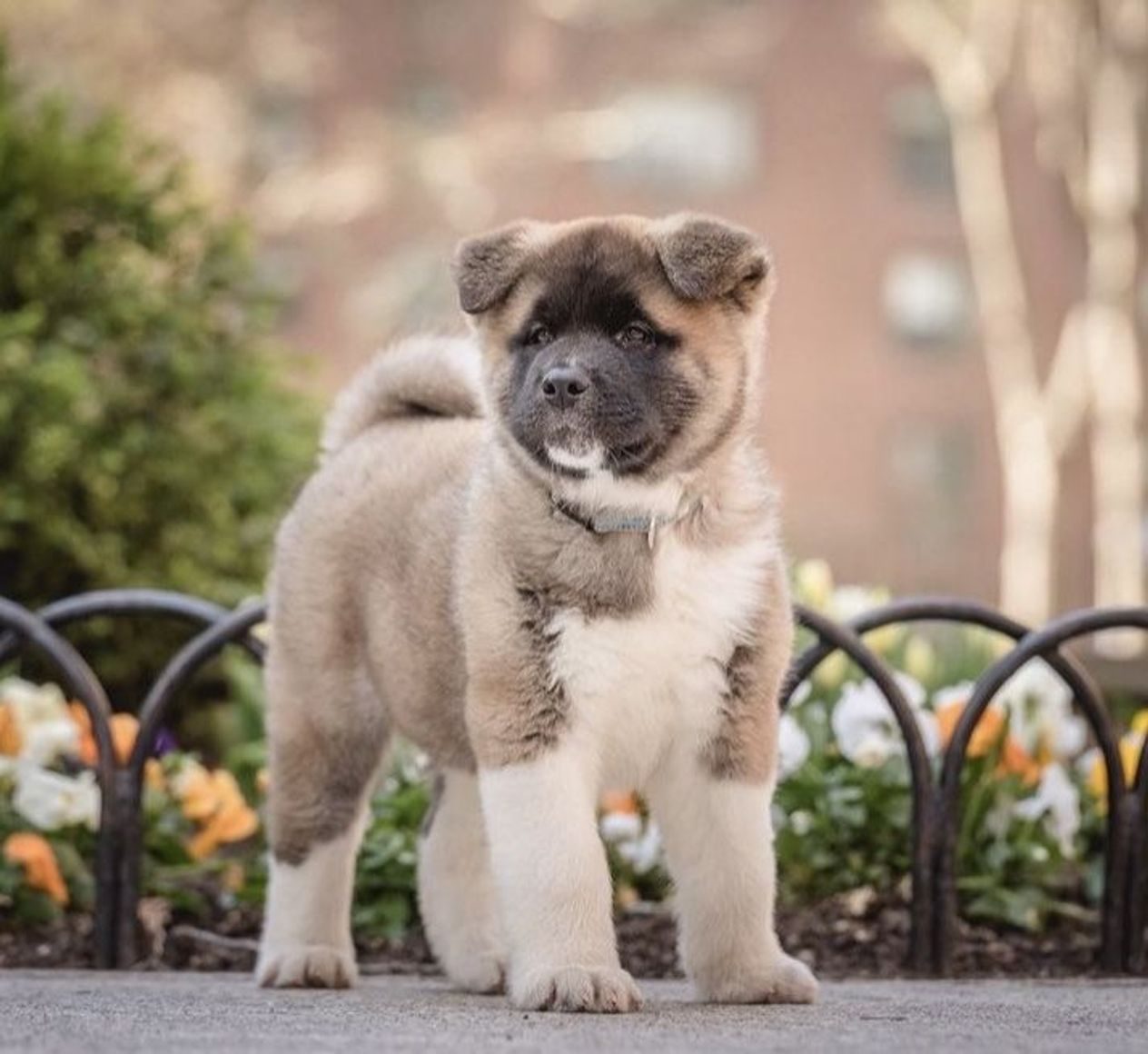Get to know
Akita

Veterinarian reviewed
The loyal Akita is brave, powerful, and protective, yet very independent.
Browse available puppies
Connect with reputable breeders to find the dog of your dreams
At a glance
Moderate Energy
Energy level
3/5
Very Low Maintenance
Grooming
2/5
Extra Large, 70 to 130 pounds
Size
Independent, protective, devoted
Temperament
10-13 years
Lifespan
Average Trainability
Training
3/5
Medium Vocality
Barking
3/5
At a glance
Energy level
Moderate Energy
Grooming
Very Low Maintenance
Size
Extra Large, 70 to 130 pounds
Temperament
Independent, protective, devoted
Lifespan
10-13 years
Training
Average Trainability
Barking
Medium Vocality
Why people love the breed
People love Akitas because of their rich heritage, strong physique, and mostly, their loyal and protective nature.
Appearance
The Akita has a general spitz body type. They were designed to hunt big game through deep snow and over rough terrain. They combine strength with agility.
Grooming
Grooming is simple, but can be intensive during shedding season.
Tablerock Akitas
Breed temperament and characteristics
The Akita is a one family, even one person dog. They are selective in their affections, devoted only to a special inner circle.
Exercise
Akitas are large, athletic dogs bred to overtake and subdue large dangerous animals. They will not be content to stay inside sleeping all day.
Gallant Akitas
Training
Akitas are willing to please, but just as willing to please themselves. Don’t expect a push-button obedience dog.
Diet and nutrition
Akitas thrive on commercial or home-prepared diets (following consultation with a veterinary nutritionist) specifically formulated for large dogs.
Gallant Akitas
Health issues
Akitas are a generally robust and healthy breed that nonetheless are at risk for a few health conditions.
Lifespan: 10 to 13 years.
Hip Dysplasia
Common in large breed dogs, this complex condition involves both genetic and environmental factors and arises when the head of the femur doesn’t fit in the pelvic socket, causing arthritis and lameness. No genetic test is available to date, therefore, the recommended screening test is x-rays.
Elbow Dysplasia
Found more often in larger breeds, this is a condition in which the elbow joint develops inappropriately, causing arthritis and lameness. No genetic test is available to date, therefore, the recommended screening test is x-rays.
Hypothyroidism (underactive thyroid gland)
reported at a higher incidence in Akitas compared to other breeds.
Gastric Dilatation-Volvulus (GDV, Bloat)
Akitas, like most deep-chested breeds, are at increased risk for GDV, a life threatening emergency in which the stomach twists within the abdomen.
Pemphigus foliaceus
An immune-mediated skin disease that causes hair loss, lesions, cracks and swelling of the skin around the head and feet, occurs at a higher rate in Akitas compared to other breeds.
Uveodermatologic (VKH-like) syndrome
An immune mediated eye and skin disease, occurs in Akitas at a higher rate than in other breeds.
History
According to DNA studies, Akitas are among the most ancient of breeds.
About the author
Canine specialist, Caroline Coile, Ph.D., is the author of 34 dog books, including the top-selling Barron's Encyclopedia of Dog Breeds. She’s written thousands of magazine and web articles about dogs. She specializes in canine science, health, breeds and competitions. Caroline has won 20 national dog-writing awards, and was a 2015 Inductee into the Dog Writers Association of America Hall of Fame.
Veterinarian reviewed
Dr. Nate Ritter, DVM is the Veterinary Medical Director at Good Dog. He earned his Bachelor of Science in Biology from Lafayette College and his Doctor of Veterinary Medicine degree from Virginia-Maryland College of Veterinary Medicine. He is a member of the American Veterinary Medical Association, New York State Veterinary Medical Society, the Veterinary Medical Association of New York City, and the Society for Theriogenology. Additionally, he is a USDA-accredited veterinarian.
Breed Scorecard
Characteristics and temperament
Affectionate with family
3
Watchdog level
5
Playfulness
3
Adaptability
2
Social needs
3
Temperament
Independent, protective, devoted
Intelligence
4
Good with other dogs
1
Good with cats or other pets
2
Friendly with strangers
1
Good as a service dog
2
Good for apartments
2
Barking level
3
Appearance
Height
24-28"
Size
Extra Large, 70 to 130 pounds
Colors
Silver brindle, Brown, White, red shading, Black, fawn undercoat, Black, silver undercoat, Black, red undercoat, Black, brown undercoat, Fawn brindle, Red brindle, Silver, Black brindle, White, Black, Brown brindle, Brown, black overlay, Fawn, Fawn, black overlay, Red, Red, black overlay, Silver, black overlay
Coat texture
Harsh
Coat length
Medium
Training
Trainability
3
Exercise
Exercise needs
3
Exercise time
One hour daily
Mental exercise needs
3
Favorite activities
Hiking
Grooming
Grooming needs
2
Brushing frequency
Weekly
Needs professional grooming?
No
Drooling level
3
Health issues
Hip Dysplasia
Elbow Dysplasia
Hypothyroidism (underactive thyroid gland)
Gastric Dilatation-Volvulus (GDV, Bloat)
Pemphigus foliaceus
Uveodermatologic (VKH-like) syndrome
Other
Bred for
Big game hunting, fighting, guarding
Country of origin
Japan
Popularity level
3
FAQs
On Good Dog, you can search for Akita puppies or dogs in rescues and shelters. Adopting an Akita from a shelter or rescue is generally less expensive than buying a puppy from a breeder with ethical practices. Across the United States, there are dedicated rescues that specialize in specific breeds and may even help transport an Akita dog to you from another part of the country. Although it can be more cost-effective, adopting the exact breed you're looking for is typically more difficult than working with a responsible breeder. Learn more about adopting a dog from a shelter or rescue.
Prices for puppies vary by breeder and individual puppy. On Good Dog today, Akita puppies are typically around $2400. Because all breeding programs are different, you may find dogs for sale outside that price.
No. This is a strong, independent, breed that can be aggressive if not trained and socialized correctly. They are not dogs for beginners.
It’s hard to quantify, beyond saying they are almost certainly more powerful than you.
Yes, both are members of the spitz family of dogs. In fact, according to DNA evidence, the Shiba Inu is probably the Akita’s closest relative.



